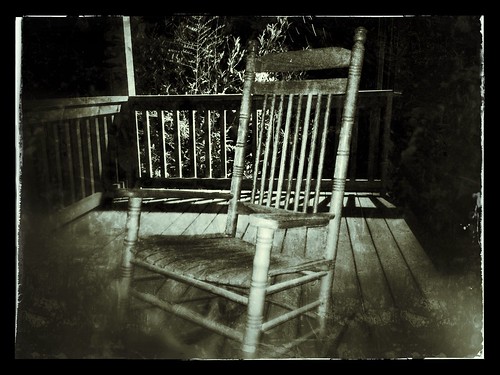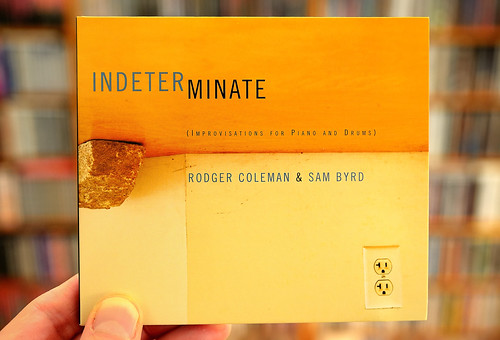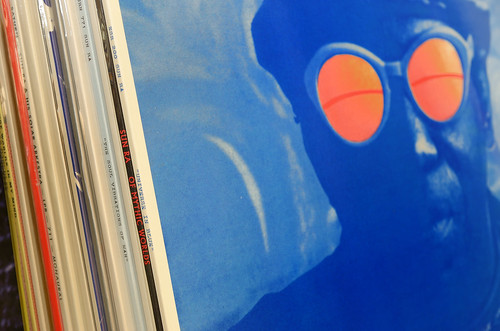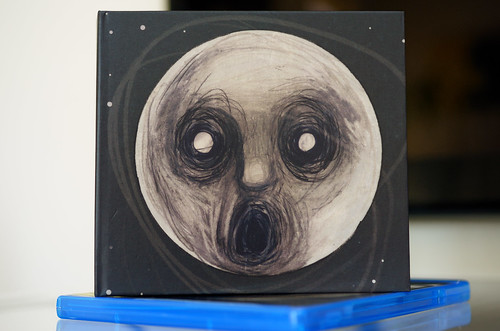* Vivaldi: Late Concertos, RV 386, etc. (Venice Baroque
Orchestra/Marcon/Carmignola) (Arkiv Prod. CD)
* Vivaldi: Concertos, RV 331, etc. (Venice Baroque
Orchestra/Marcon/Carmignola) (Arkiv Prod. CD)
* J.S. Bach: Sonatas & Partitas For Violin Solo (Holloway) (ECM
2CD)
* Miles Davis: Kind Of Blue (Columbia/Legacy SACD)
* Sun Ra: Interplanetary Melodies: Doo Wop From Saturn And Beyond Vol.1
(Norton CD)
* Sun Ra: The Second Stop Is Jupiter: Doo Wop From Saturn And Beyond
Vol.2 (Norton CD)
* Sun Ra: Rocket Ship Rock (Norton CD)
* Sun Ra: Bad And Beautiful (Saturn LP)
* Sun Ra: Cosmic Tones For Mental Therapy (Saturn LP)
* Sun Ra: Other Planes Of There (Saturn LP)
* Sun Ra: My Brother The Wind Vol.1 (Saturn LP)
* Sun Ra: My Brother The Wind Vol.2 (Saturn LP)
* Sun Ra: Night Of The Purple Moon (Saturn LP)
* Sun Ra: Universe In Blue (Saturn LP)
* Sun Ra: Unity (Horo 2LP>CDR)
* Sun Ra: The Soul Vibrations Of Man (Saturn LP)
* Sun Ra: Of Mythic Worlds (Philly Jazz LP)
* Sun Ra: New Steps (Horo 2LP>CDR)
* Sun Ra: Other Voices, Other Blues (Horo 2LP>CDR)
* Sun Ra: The Mystery of Being: The Voice Studio Sessions, Rome 1978
(Horo/Klimt 3LP)
* John Abercrombie Quartet: Wait Till You See Her (ECM CD)†
* Mary Halvorson Quintet: Saturn Sings (Firehouse 12 CD)
* Mary Halvorson Quintet: Bending Bridges (Firehouse 12 CD)
* Frank Ocean: Channel Orange (Island/Def Jam CD)
* Miguel: Kaleidoscope Dream (RCA CD)
* Yes: Close To The Edge (Atlantic/Audio Fidelity SACD)
* Genesis: Nursery Cryme (Charisma LP)
* Genesis: Foxtrot (Charisma LP)
* Camel: A Live Record (Decca/EMI 2CD)
* Chris Bell: I Am The Cosmos (Expanded Edition) (Rhino Handmade 2CD)
* Phil Collins: No Jacket Required (Atlantic/Audio Fidelity CD)
* Phil Collins: …But Seriously (Atlantic/Audio Fidelity CD)
* The Fall: The Wonderful And Frightening World… (Omnibus Edition)
(d.1-3) (Beggar’s Banquet 4CD)
* Guided By Voices: Forever Since Breakfast (Matador CDEP)
* Guided By Voices: The Devil Between My Toes (Scat CD)
* Guided By Voices: Sandbox (Scat CD)
* Guided By Voices: Self-Inflicted Aerial Nostalgia (Scat CD)
* Guided By Voices: The Same Place The Fly Got Smashed (Scat CD)
* Pavement: Crooked Rain, Crooked Rain (Matador LP)
* Pavement: Crooked Rain, Crooked Rain: LA’s Desert Origins
(selections) (Matador 2CD)
* Kyuss: Blues For The Red Sun (Dali CD)†/‡
* Porcupine Tree: In Absentia (Lava/Atlantic CD)
* Porcupine Tree: Deadwing (Lava/Atlantic CD)
* Steven Wilson: The Raven That Refused To Sing And Other Stories (KScope BD)
* Opeth: Orchid (Candlelight CD)
* Opeth: Morningrise (Candlelight CD)
* Opeth: Morningrise (Candlelight CD)
* Opeth: Still Life (Peaceville CD/DVD)
* Anathema: A Natural Disaster (Music For Nations/Sony CD)†/‡
* Anathema: We’re Here Because We’re Here (KScope CD/DVD)
* Anathema: Weather Systems (The End CD)
†=iPod
‡=car
Commentary:
I got into
Steven Wilson via my
Opeth obsession over the last year or
so—but I have conflicting opinions about his work. Wilson co-produced Opeth’s
landmark albums
Blackwater Park (2001),
Deliverance (2002) and
Damnation (2003),
mixed their most recent record,
Heritage (2011) and joined forces with Mikael Åkerfeldt
on last year’s weird and wonderful
Storm Corrosion LP. Figuring what’s good
enough for Åkerfeldt is good enough for me, I decided to check out some of
Wilson’s vast catalog. I was vaguely aware of
Porcupine Tree prior to this but
thought the name was dumb (and it is)—but I have to admit, their string of
albums from
Stupid Dream (1999) through
Deadwing (2005) are all pretty great, evolving
from psychedelic, Pink Floyd-inspired prog through Radiohead-esque post-rock
romanticism to nu-metal’s technical heaviness. (Incidentally, these records parallel
Wilson’s intimate involvement with Opeth, with Åkerfeldt himself making an
appearance on
Deadwing). Of course, Wilson is also became well
known for his production and re-mix work, revamping progressive rock classics
from bands like King Crimson, Emerson Lake & Palmer and Jethro Tull. As I’ve
written here
before, the
40th Anniversary editions of the King
Crimson catalog are truly definitive. One thing you can almost always count on with
Wilson is superb sound quality. A strong proponent of high-resolution digital, his
remixes and surround-sound presentations are state of the art.
Nevertheless, there are several things about Wilson that bug me. For one, the
sound quality is sometimes almost too pristine. On “The Sound of Muzak” (In
Absentia) Wilson morosely sings about the perceived sad state of the music industry: “Soul gets
squeezed out/Edges get blunt.” Yet that is exactly what Wilson does to his own
recordings, polishing every track to a gleaming, glassy smooth surface with nary
a trace of jagged edge or loose end—even when the song might benefit from some grit and
grease. Then there’s his dour, self-serious persona and far too many songs
about the evils of drugs and the iPod. OK, fine; I’m an audiophile and I love
my iPod—please stop treating me like an idiot! Moreover, his morbid fascination with
serial killers is an adolescent fixation that seems immature and pathetic in an
adult, no matter how clever the songwriting. There is a humorless quality to
Wilson’s music that can oftentimes make for dreary, depressing listening. But the
thing is: he has such a gift for melody and form that the music is almost
always compelling, if not transcendent.
It would seem Wilson needed to break free from the confines of
Porcupine Tree to really find his voice and start to mature as an artist. His first solo
album,
Insurgentes (2008), was wildly diverse, as if he was trying to cram
every kind of music he could into one record, resulting in a fascinating but frustratingly
inconsistent finished product.
Grace For Drowning (2011) was better: obviously
inspired by his remixing projects for King Crimson, Wilson hired top-flight
musicians for this sprawling double-album of
Lizard-esque, jazz-inflected prog. While
Wilson’s lyrical obsessions remained constant, the music was starting to open
up, allowing for high-stakes improvisation and developing a much-needed edge. A
touring band was assembled that was able to take these songs to another level
on stage, as demonstrated on last year’s live CD/DVD/Blu-Ray,
Get All You Deserve. While Wilson is a serviceable guitarist,
Guthrie Govan is a true
virtuoso—as are keyboardist
Adam Holzman (who played with Miles Davis in the ‘80s),
woodwind player,
Theo Travis, bassist
Nick Beggs and drummer
Marco Minnemann. A
new song, “Luminol,” was written expressly for this band and debuted on the
road (and was previewed on
Get All You Deserve). Immediately upon the tour’s
conclusion, Wilson quickly demoed an album’s worth of songs and set to work
recording with the band in September 2012. The result is
The Raven That Refused
to Sing and Other Stories, perhaps Wilson’s finest achievement so far.
Well, the first two tracks, “Luminol” and “Drive Home” are certainly
some of the most musically satisfying and emotionally riveting songs Wilson has
ever recorded. “Luminol” gleefully references every prog-rock-god move
imaginable, including tricky time signatures, dramatic mood swings and loads of
overdubbed Mellotrons. That would be good enough me but Wilson sings
sympathetically (perhaps metaphorically) of a street musician who remains as
anonymous is death as in life. “Drive Home” digs deeper: an ambiguous lament
for a lost loved one, either real or imaginary, it features one of the most
gorgeous, layered choruses in the Wilson canon as well as a spiraling,
spine-tinglingly thrilling guitar solo from Govan. The rest of the album fails to live up
to the promise of those opening tracks—but only by comparison. “The Holy
Drinker” boasts some killer grooves and rocking guitars, but the dirgey,
sanctimonious middle section nearly derails the momentum. “The Watchmaker”
evokes Steve Hackett-era Genesis with its chiming acoustic guitars and portentous,
quasi-atonal coda but its multi-part construction doesn’t quite cohere and its
murderous undertones are unnecessarily, childishly creepy. The title track, which concludes
the album, returns to another song about grief and longing, a plaintive,
post-rock piano ballad surrounded by soaring, redemptive strings. When Wilson
sings the refrain, “Sing to me Lily/I miss you so much,” the emotion is eerily tangible
despite all the deliberately obfuscatory electronic processing. What is most striking about
The Raven That Refused to Sing is the maturity and sophistication of Wilson’s lyrics
and subject matter. Sure, death and despair are still central to his concerns—but
the words and his singing have never been quite so emotionally direct, as if death
is no longer an abstraction to be contemplated at an ironic distance but real, complicated reality.
As usual with Wilson, there are a variety of formats to choose from,
depending upon your level of fan commitment and overall
audiophilia: there’s
the regular CD (which sounds quite nice, actually); a deluxe CD+DVD combo,
which includes a 24/48 stereo and lossy 5.1 mix; a Blu-Ray disc with 24/96 stereo and
lossless 5.1 mixes plus bonus tracks; and, finally, a super-deluxe 2-LP/2CD/DVD/Blu-Ray
package that I believe is already sold out and out of print. The Blu-Ray is
fantastic—who needs vinyl when digital can sound this good? I also picked up
the CD/DVD combo for portability and the extra artwork, which adds another
layer of interpretation to these enigmatic lyrics. Oh, I guess you can buy (or
steal) an MP3 if you want—but why would you? Wilson hired the legendary
Alan Parsons (he of
Dark Side of the Moon fame) to engineer and co-produce T
he Raven
That Refused to Sing—and the sound quality has a heft and solidity that
complements and enhances Wilson’s perfectionistic, anal-retentive tendencies.
It really does sound amazing—why skimp and deprive yourself the pleasure?
Wilson’s eagerness to write for this phenomenal band and naturally prolific
nature may have rushed
The Raven to market, but it’s a huge step forward in
almost every way.













